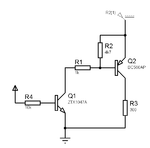skywalker898
Member level 1
- Joined
- Jan 31, 2012
- Messages
- 32
- Helped
- 0
- Reputation
- 0
- Reaction score
- 0
- Trophy points
- 1,286
- Location
- Madison, WI
- Activity points
- 1,622
Hi, I would like to use an npn transistor as a high side switch, but I have seen multiple websites stating that a pnp transistor should be used for a high side switch. Could someone tell me if it matters whether the npn transistor is used as a high side switch vs a low side switch? I don't understand why it matters whether the load is on the collector vs the emitter. Please see the simple example I uploaded.

Also, in my actual application, I need a high side switch (to switch 90V DC) that I can control with TTL voltage levels. Can I do this with an npn transistor (or multiple)? For example, take my LED switch example, how can I use npn transistors to switch 90V DC using only 5V TTL output from my microprocessor.
Thanks,
Brandon

Also, in my actual application, I need a high side switch (to switch 90V DC) that I can control with TTL voltage levels. Can I do this with an npn transistor (or multiple)? For example, take my LED switch example, how can I use npn transistors to switch 90V DC using only 5V TTL output from my microprocessor.
Thanks,
Brandon
